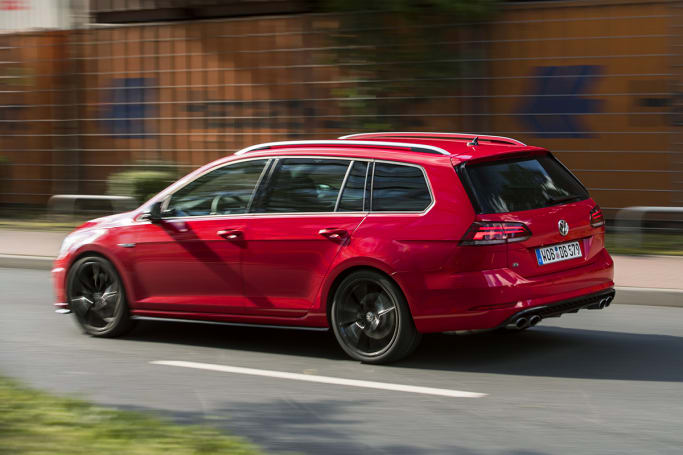
According to Car and Driver (on the latest Golf R the.
The engine is the real star, here. The Golf GTD uses a 2.0-litre diesel engine producing 181bhp and 280lb ft of torque, giving it a 0-62mph time of 7.5sec (or 7.4sec if you opt for the DSG gearbox). There's a hefty rush of power as the turbo kicks in, followed by a broad mid-range that's potent enough to give the GTD serious pace. It also sounds quite appealing by diesel standards, with a sporty rasp as the revs rise beyond 3500rpm.Despite its strong torque, the GTD suffers from little of the wheel scrabbling under heavy acceleration that's common in high-powered front-wheel-drive cars. An electronic traction control system helps here, because it works like a limited-slip differential to improve traction on the exit of corners and can also brake the inside wheels midway through bends to improve agility.Crucially, apart from more road noise at motorway speeds, the GTD compromises little of the standard Golf's usability in the name of fruitier performance; it remains a relaxing daily driver, with a relatively comfortable ride.Adaptive dampers are available as an option, but since standard suspension balances comfort and fun well enough, you’re better off saving your money.
The built-in stopwatch is perfect for timing approaches, and if your PC lacks available USB ports, an integrated USB Hub. Can bms be installed on top of falcon 4.0 for mac pro. Whether navigating the front-to-back, side-to-side, or vertical axes, all controls are right at your fingertips. Pro Flight Yoke with Durable Metal ShaftUnlike the mostly plastic offerings on the market, Saitek's Pro Flight Yoke utilizes a durable stainless steel shaft with precision bearings for smooth, predictable elevator and aileron control.
Traction control helps limit tire slip in acceleration on slippery surfaces. In the past, drivers had to feather the gas pedal to prevent the drive wheels from spinning wildly on slippery pavement. Many of today's vehicles employ electronic controls to limit power delivery for the driver, eliminating wheel slip and helping the driver accelerate under control.

Powerful rear-drive cars from the sixties often had a primitive form of traction control called a limited slip rear differential. Sometimes referred to as Positraction, a limited-slip rear axle will mechanically transfer power to the rear wheel with the most traction, helping to reduce, but not eliminate wheel spin. While limited-slip rear axles are still in use in many front- and rear-drive vehicles today, the device can't completely eliminate wheel slip. Hence, a more sophisticated system was needed.
Advertisement
Enter electronic traction control. In modern vehicles, traction-control systems utilize the same wheel-speed sensors employed by the antilock braking system. These sensors measure differences in rotational speed to determine if the wheels that are receiving power have lost traction. When the traction-control system determines that one wheel is spinning more quickly than the others, it automatically 'pumps' the brake to that wheel to reduce its speed and lessen wheel slip. In most cases, individual wheel braking is enough to control wheel slip. However, some traction-control systems also reduce engine power to the slipping wheels. On a few of these vehicles, drivers may sense pulsations of the gas pedal when the system is reducing engine power much like a brake pedal pulsates when the antilock braking system is working.
Windows 10 enterprise applocker. Many people mistakenly believe that traction control will prevent their vehicle from getting stuck in the snow. This couldn't be further from the truth. Traction control does not have the ability to increase traction; it just attempts to prevent a vehicle's wheels from spinning. For drivers who routinely drive in snowy and icy conditions, traction control, antilock brakes, and snow tires are must-have safety features.
Related HowStuffWorks Articles